
David Wasserman and I worked together at the Southface Energy Institute back in 2007-08 and have been friends since then. Before Southface, he was an engineer at Oak Ridge National Lab. We also call on him for occasional help with some of our HVAC design work at Energy Vanguard. He knows his building science, especially the mechanical side. So when he posted a comment in another article about the hot water system retrofit he’s done on his own house, I wanted to see it.
The article where he posted that comment is the one I wrote about why it takes so long to get hot water in your house. The basic problem is that a lot of hot water pipes are both too long and too big in diameter. In the article I wrote about my own house, where it currently takes two and a half minutes to get hot water at the kitchen sink. I can reduce the length of the pipe to the kitchen, but it’s the diameter that’s killing me. I’ll fix mine before long, but Wasserman has already done something about his slow hot water.
Wasserman’s hot water retrofit
I went over to his place one day last fall, and he showed me what he’s done. That’s him in the top photo pointing out the addition to his hot water pipes, with a closeup below. It’s really simple. His existing hot water lines are all 3/4-in. and 1/2-in. copper pipe. With the low-flow fixtures used in homes now, those pipes are too big. He didn’t remove them, though. He simply added a second, smaller pipe for three of his hot water runs.
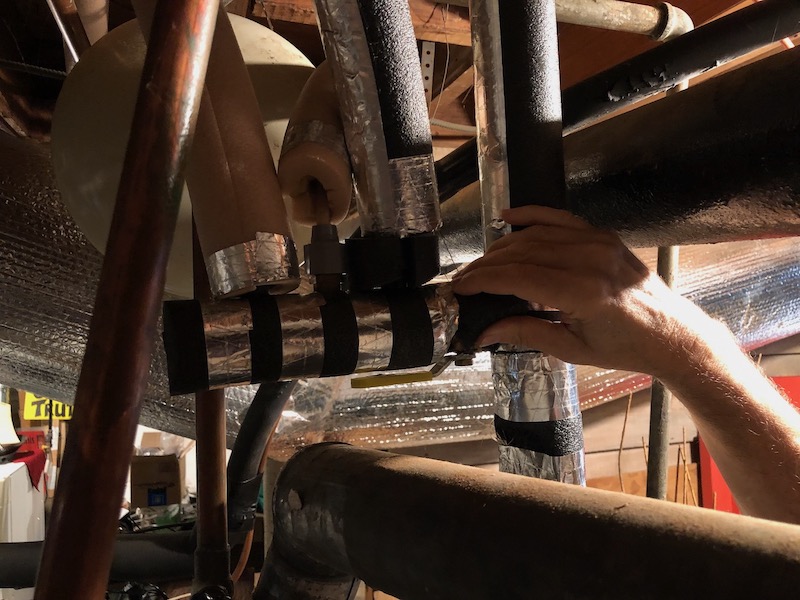
In the photo above, his hand is in front of the original hot water line coming off the top of the water heater. To the left of his hand is a short manifold he made out of copper pipe and copper tees (details below). Near his thumb is a cutoff valve for the three new hot water runs. Since it’s parallel to the manifold, you can tell the valve is open and the hot water goes that way. The three new runs go up from that manifold. They’re made of 1/4-in. PEX tubing, which you can’t see except for one little gap because they’re insulated.
In case you can’t see all that in the photo above—and it IS hard to see with the pipes all covered in thick insulation—the annotated version of the photo below should help. The numbered lines are the new 1/4-in. PEX lines he installed between the manifold and the three hot water taps. (You’ll have to look closely to see the word “valve.” I couldn’t find a color that stood out any better there.)
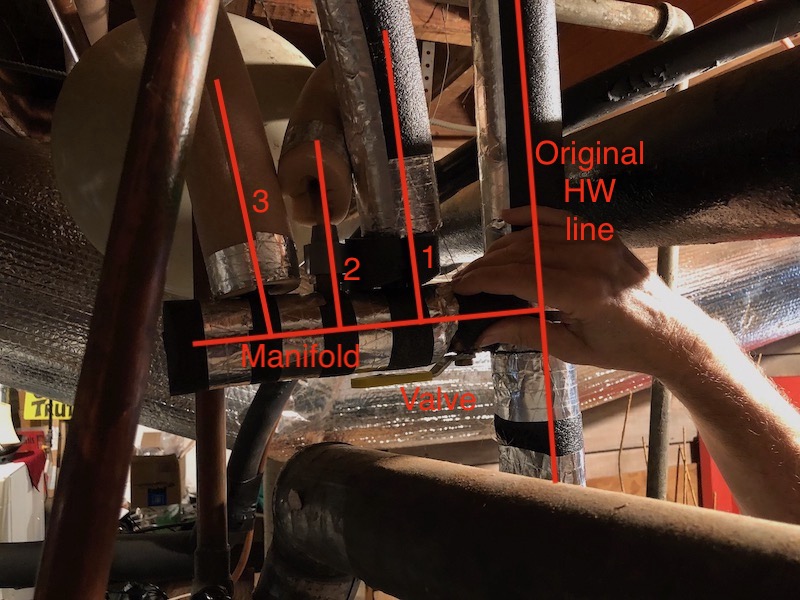
Those three PEX pipes go to three different parts of the house. The photo below shows one going into a bathroom. Since he doesn’t want hot water going through both pipes, he installed valves for the old runs near where the new run connects to it. Perpendicular to the pipe indicates that that one is off, and all hot water is coming through the 1/4-in. PEX pipe. The other two runs are set up the same way. Simple, right?
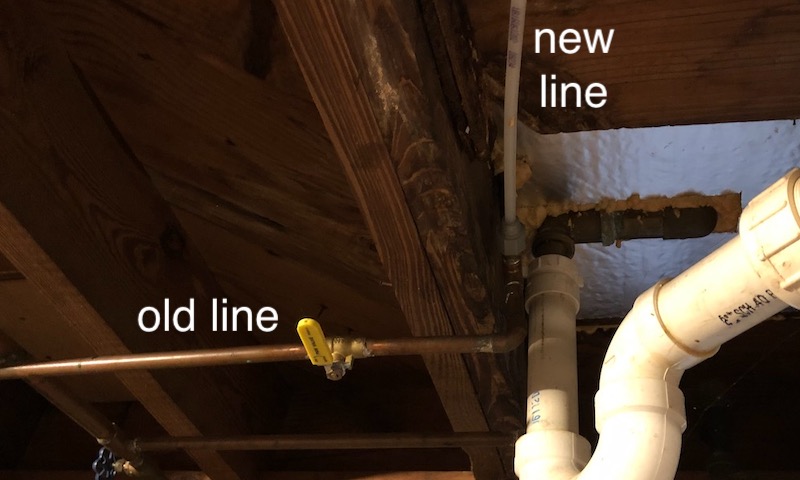
And how well does it work? He said it used to take over a minute to get hot water to his kitchen faucet. With the hot water system retrofit, it takes about 8 seconds. I verified that when I visited. They hadn’t used hot water in the kitchen yet that morning, so I turned on the tap and counted out, one-one thousand, two-one thousand . . . when I got to 7 seconds, the hot water was there.
Retrofit details
If you’re interested in the parts he used and other details, here’s what he wrote in his comment on the other article:
- Attach a 3/4-in. to 3/4-in. copper Tee as close as you can to the water heater outlet.
- Create a manifold consisting of 3/4-in. to 1/2-in. copper Tees connected by 3/4-in. stubs. Put as many Tees on it as you need. End the manifold with a cap, not a 90° bend.
- Attach 1/2-in. copper male adapters to each branch of the manifold.
- Thread on a Sharkbite reducing adapters.
- The PEX tubing then slips into the adapter.
- At the other end, find a 1/2-in. pipe [or whatever size yours is] as close to the fixture as possible and install a ball valve. Then install a 1/2-in. to 1/2-in. Tee downstream and repeat steps 3 and 4 above.
- This insulation works well with this tubing.
Caution: Prescriptive plumbing codes don’t allow pipes as small as 1/4-in., so you may need an engineer to help if you want to go that small. You need to know the flow rate required at the end of the line. To use 1/4-in. PEX tubing, it should be about 1.8 gal. per minute or less. Also, if you need to run the PEX more than 25 ft., you’ll need to go to a larger size, too. To get a better handle on what you need, use this plastic pipe design calculator.
There you have it. David Wasserman’s method to retrofit the hot water distribution system works well in his old house. If you’re worried about this retrofit not meeting the code, which requires 3/8-in. minimum pipe, Wasserman said: “Code requires you to put in over-sized piping but it does not require you to use them!”
_________________________________________________________________________
Allison Bailes of Atlanta, Georgia, is a speaker, writer, building science consultant, and the founder of Energy Vanguard. He has a PhD in physics and writes the Energy Vanguard Blog. He is also writing a book on building science. You can follow him on Twitter at @EnergyVanguard.
Weekly Newsletter
Get building science and energy efficiency advice, plus special offers, in your inbox.





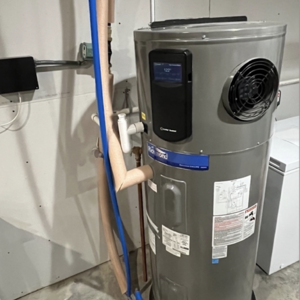
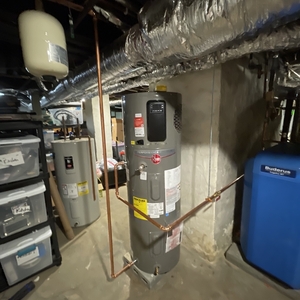

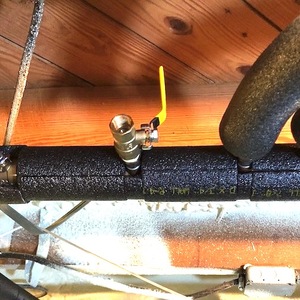






27 Comments
This is a really helpful article for those of us with an older house. Even with a relatively small plumbing footprint, the 3/4" pipe really slows down the distribution time.
Generally speaking, with an on-demand tankless water heater, are there any issues with minimum flow rates and the 1/4" pex above and beyond a more traditional tank water heater? I know that most tankless require somewhere in the ballpark of .04–.06 gpm to kick on and then about half that to maintain, but am a little unsure if that summarily means 1/4" pex is out as a possibility.
Brian: I've heard about low flows being a problem with tankless water heaters sometimes. But that's all I know on that topic, not being a tankless guy myself.
What works even better is a hot water return loop...distribution loop that runs from heater to farthest fixture, then returns to bottom of heater. Taps to each fixture from loop, so loop is like a looong manifold. No need for circulating pump, eddy currents circulate hot water. Check valve ensures direction of water flow. Loop fully insulated. Furthest fixture is 85 ft from heater, water is hot in 3 sec. Host water return loops commonly used in large commercial buildings, I adopted for my home. Very little increase in energy cost to have hot water constantly circulating.
William: That sounds very interesting. If the water stays hot enough to limit wait time to 3 seconds 85 feet from the water heater, how does that not make a significant increase in your hot water bill? Even with insulation, you're going to have heat loss. Have you monitored hot water use?
Water runs continuously by convection in the 3/4" copper loop...loop is insulated by (2) 1" layers of pipe insulated. Feeds to fixtures are mostly 3' tap of 1/2" copper, also insulated. Check valve before the first fixture tap ensures flow will start in the intended direction. Measured increase in natural gas consumption was around 5% - between $4 and $5 /mo. During heating season, all the leak heat goes into warming the house, reducing heat input from gas furnace, so 8 months of year effectively no extra cost to account for circulating loop heat loss. No waste of hot water since loop runs from top of water heater back into bottom, tee'd into the stub for the drain valve. It all works like a champ!
While we've installed several loops as you describe--successfully (we used to omit the pump and see if it looped by convection, often enough it did)--they're prohibited in the IECC (R403.5.1.1, aka IRC 1103.5.1.1), in favor of demand-controlled pumps.
As licensed PE, designed many commercial systems with a hot water return loop, including a circulating pump. Thought it would be a great idea to incorporate into my own home. Installed hot water supply in manifold fashion out to farthest fixture. After plumbing inspection, after construction complete and home was occupied, ran return run back to tee at bottom of water heater that led to drain valve. Just above tee, installed 2 unions with a length of pipe in between where I could install a circulating pump. Never could reconcile the $250 cost of a proper pump, and the system worked so well without it, I "forgot" to ever put a pump in...
"If you’re worried about this retrofit not meeting the code, which requires 3/8-in. minimum pipe, Wasserman said: “Code requires you to put in over-sized piping but it does not require you to use them!”
I'm sorry, but I don't understand what he is suggesting at all.
He seems to be suggesting that you may have to build to the code, but they can't stop you from going in after the fact and changing it. The only other interpretation I can imagine is that he's suggesting you can run smaller lines right beside the code compliant lines, and just not hook up the code compliant lines. But that is kind of crazy, as I don't think you'd convince an inspector that you met the code requirement in such a manner.
Trevor,
If that's what he is suggesting - that you get an inspection and then alter the plumbing to be non-conforming - I don't see how that alleviates worries that your plumbing won't meet code?
Malcolm, the system that David retrofitted has two parallel hot water lines to three of his fixtures. One is the existing, oversized pipe. The other is his new 1/4" PEX line. The original hot water line is still there and functional, but he's installed valves that let him instead send the hot water through the new, smaller, non-compliant line.
Allison,
I'm not sure it's important enough to spend a lot of time over, but I don't see that there is any middle ground here. You either have a house with code compliant plumbing, or you don't. I think a more accurate description of your legal obligations would be "The code requires you to size any waterlines servicing a fixture according to the tables it supplies" . I don't see this as being any different than running a parallel set of 14/2 wiring to your 12/2 supplied kitchen outlets because you only ever use a small blender.
Malcolm, I agree. But the code applies only when you're building or doing work for which you pull a permit or when an inspector calls out issues for a sale. If David were to sell, he may have to change what he's got.
And the other side of this issue is that so far, we've been using the word "code" to mean the prescriptive version of the code. You can comply with code with 1/4" pipe by getting a licensed engineer to approve it. David is a licensed engineer, so he could go that route, too.
Allison,
"But the code applies only when you're building or doing work for which you pull a permit or when an inspector calls out issues for a sale. "
That's not quite correct. Codes apply every time you or a trade does work on a building, whether you pull a permit or not. I think you are confusing getting caught for non-compliant work, with doing the work itself.
The only instance I can think of when houses are not expected to meet codes, is when codes themselves change. Owners are not typically required to update their existing houses to meet new codes unless they decide to do renovations or upgrades.
I'm persisting in what is a bit of a pedantic point because I think there is a lot of confusion around when codes apply, whose obligation it is to meet them - and possible work-arounds like the one that started this discussion.
Malcolm: I stand corrected. You make an important point, and I should have known this. My excuse is that I'm not a contractor or building official, so I'm not on the front lines of code implementation or enforcement. Thanks for helping me understand this better.
Allison,
What a generous post. My intention was never to disparage your work, and I'm sorry if this side issue detracted from what is an interesting and useful blog. I have learned a lot from your writing over the years, and am therefore in your debt.
Malcolm: I didn't see any hint of disparagement in what you've written here. And I've learned from 12 years of blogging that a good percentage of the comments are on side issues or parts of an article that I consider minor. That's OK. I've learned a lot from comments over the years.
He's got the perfect name, Wasserman in German means Waterman in English. Great solution.
That may be so, Walt. It fits in this case, but his main work is on the energy side. Maybe he's got a new career in plumbing ahead of him. ;~)
I had to re-read this article a couple of times. I think the recommendation is to add a manifold to the large HW line near the water heater, and run 1/4" lines directly to your low flow fixtures. At the fixture end, the new line is connected to the existing HW line with a tee, and a valve is installed upstream of the tee to shut off the flow from the now-redundant, larger HW line. I agree using smaller lines is a great idea. And I understand the reason for leaving the old lines intact, since it doesn't require you to tear apart the whole system, and fixtures you don't convert to smaller lines will still work without re-plumbing. Does leaving the old lines intact and shut off at the fixture ends create "dead legs", which can pose stagnation / health risks?
Doug: Yes, I think it does create dead legs, which I learned about after I first published this article in the Energy Vanguard Blog. That might be a good reason to set it up differently, maybe with a valve at both ends of the dead legs.
Ahhh, thanks. I found your energy Vanguard blog - lots of interesting topics there! And I now see Larry W.'s similar comments.
A little off topic, but perhaps informative: In our basement, we have hose spigots formerly used for a washing machine. In the winter, I sometimes use the cold water fitting to attach a garden hose, which I pull out through the bulkhead periodically to do things like ice the outdoor skating rink, hose salt off the car, etc.
If I don't shut off the cold water valve and leave the hose attached, the garden hose becomes part of the house's water system. You'd think it was similar to a "dead leg", but because the hose expands over time when pressurized, it's actually very much alive!
I learned this the hard way.
After several days of noting that our water had a bad taste, It occurred to me that I'd left the old washer valve open. The brand new hose I'd hooked-up a few days earlier was ballooning when there was no domestic water demand... and when someone turned on a faucet, the hose would contract, and expel its toxic contents back into the domestic water piping!
That was a pretty vivid demonstration of the dynamic nature of water flow, and why siphoning/backflow is the reason behind many plumbing codes. I wonder how many people leave pressurized garden hoses attached to their grandfathered outdoor spigots - with no backflow preventer - and are unwittingly exposing themselves to all kinds of nasty compounds like phthalates, lead, etc.?
Doug,
The consequences can be very serious. As you say, the hose can pull contaminants like E coli, or pesticides that are designed to be applied by attachment to a garden hose, into the water system. I once watched a hose attached to a waterline which had become depressurized drain a large mud puddle back into a house.
Sounds like the code requirement is a problem here, is there any argument for having the larger lines, when they are just serving low flow features? Why hasn't the requirement changed with the flow rates?
James,
Codes are typically pretty conservative about downsizing the requirements for services based on current practices. You may recall Trump ordered a review of water-saving toilets which were mandated by many states at the time.
Ah, "best to have sufficient capacity for when this water saving craze runs its course" or "well, people might want a five jet shower there in future". Wait, I know, it's the low flow fixtures that are causing everyone to wait for hot water in the first place, right?
James, as I just replied to Malcolm above, the way around that prescriptive code requirement is to get a licensed engineer to approve 1/4" pipes.
Log in or create an account to post a comment.
Sign up Log in